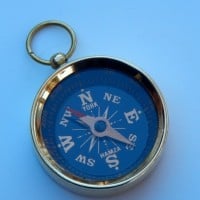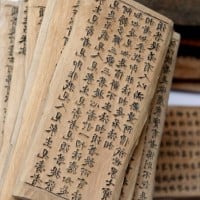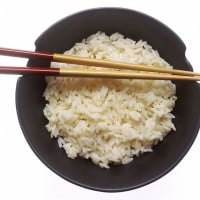Top 10 Greatest Inventions From China
China is home to many inventions that has changed the course of human history - notably the Four Great Inventions, which include paper, printing, gunpowder, and the compass. Not surprisingly, most of the everyday objects we use came from China, hence that familiar label "made from China". Aside from the four great inventions included, this list provides the top six other noteworthy inventions from China.
One of the most influential inventions coming from the four great inventions. Although paper had already existed since the 3rd century BCE (which was made by bamboo and silk), Cai Lun suggested tree bark and hemp to be used in the production of paper. In result, this made paper production much more efficient and widespread not only in China, but all over the world in later times. Overtime this shifted the course of human history given that more paper led to more literature, better mediums of communication, and documentation.

Gunpowder, a part of the four great inventions. What's surprising is that gunpowder was invented by accident. One of the most used explosives in the world can be traced back into China. Gunpowder was first documented around 142 AD, with Wei Boyang creating the first recipes of explosive powders that would "fly and dance" in a vigorous manner. These powders - though unnamed, bear many similarities to gunpowder. Gunpowder was used in a recreational manner, but not yet used as a tool of war. Later on, Ge Hong in the Jin dynasty documented the ingredients of gunpowder, which was the mixture of charcoal, sulfur, and potassium nitrate. Later on it was the first time when in 904 AD, gunpowder was used against the Mongols by the use of fire arrows, one of the first weaponized uses of gunpowder.

The second invention out of the four great inventions is the compass. While the compass today is used for navigation, it was formerly one of the most influential tools for trading and wars. Surprisingly, the first chinese compasses were invented starting from the 4nd century BC, which is used not for navigation, but for divination, worshiping, and other spiritual purposes. These weren't the compasses you usually see today, but they were in the form of lodestones (a natural magnet which aligns itself according to magnetic fields of the earth). Other types of compasses are also invented in China. One notable type of an ancient compass is a lodestone consisting of a spoon aligning towards one of the cardinal points, which is considered to be one of the first magnetic compasses.

As part of the four great inventions, various techniques of printing were invented starting in the early 7th century in the Tang Dynasty, mostly printing by wooden blocks, or also known as woodblock printing. This is done by writing the text on paper, placing the text with the ink facing the wooden board, and carving out the text to make a woodblock print. Although the process of this method along with proof-reading is tedious, woodblock prints can be used over a thousand times, thus creating numerous copies. Later on, a more advanced technique called a moveable type was invented, which was very effective for creating mass copies of books and other literature. Though the method was not as widespread in china. Around the 15th century it made a huge positive impact in Europe as well as literacy rates when the same methods were developed.

It's no doubt that most explosive inventions tend to originate from China, especially one that is considered one of the most powerful and reliable military weapon. The first rockets appeared in the Song Dynasty starting in the 13th century which spread during the Mongol invasions. Not only China invented rockets per se, but rocket launchers in the form of bamboos and wood, which were capable of firing fire arrows as early as the 11th century.

You've never thought that one of these bathroom items also came from China. It was first mentioned in the late 6th century. This indicates that China had been using toilet paper way before the rest of the world discovered them.

This isn't really a complete list if we would've not included one of the most iconic eastern utensils. Chopsticks first come to your mind when you think of China or any eastern country. Not surprisingly, China was one of the first civilizations to invent chopsticks, and was especially used as far as the Shang dynasty. According to Sima Qian, King Zhou was the first person to make chopsticks during that time - not made out of wood, but ivory.
I still can't for the life of me use chopsticks properly.

No doubt would you see this here since China already was advanced when it comes to explosives. Cannons may have appeared and depicted in works as early as the 12th century in China. The Wuwei bronze cannon is probably the oldest existing cannon in the 13th century.

The purpose of kites were very different in ancient history, as well as their composition. Ancient Chinese kites were made out of wood and were shaped like birds, which are surprisingly used for military purposes. Aside from recreational purposes, modern chinese kites are usually associated with spirituality and mythology.
With plenty of explosives being invented in china it's no doubt that land mines were also invented here. The first known use of a land mine is reported in the 13th century, precisely in 1277 in a battle against the Mongols.

Cast Iron is especially useful in cooking equipment and is considered one of the most used materials in engineering applications. In fact, one of our everyday items can be traced back into ancient China. According to archaeological evidence, it was reported that cast iron was made by smelting pig iron as early as the Zhou Dynasty. Tools and weapons made out of cast iron were favored due to their reliable convenience.

Porcelain is typically used in decorative objects, but did you know that this material is also commonly applied in crockery and even laboratories? It's also one of the most common materials you see in bathroom objects such as toilets. It was first invented in the Shang dynasty over three thousand years ago. The creation and the spread of porcelain was more gradual compared to most inventions, but its use has slowly grown onto nearby eastern countries, and into the rest of the world overtime.

In the ancient times, the wheelbarrow was considered one of the most useful vehicles used to transport heavier loads in an efficient manner. The first wheelbarrows may be traced back in China according to archaeological evidence, precisely in the Han dynasty during the 2nd century. This can be proven by one of the ancient tombs showing a wheelbarrow drawn in the same period.
Personally I would rank this higher it's an extremely useful invention.

It is known that plenty of the best teas comes from Asia. The tea culture has been around in China spiritually and physically influenced people for thousands of years. It is known that tea was consumed by Asians for centuries, if not even millennia. In the ancient times, tea was consumed for medicinal purposes instead of as a drink, especially in Yunnan. The first documented method of boiling tea was reported in 59 BC. Due to the rich history of tea culture, it's no doubt that China was also the first to invent the teapot during the Yuan dynasty.

Silk was especially used for making textiles and papers. Ancient China was the first civilization to put silk into use in making fabrics, which long contributed to their economy.
The exact location of where crossbows have been invented is unknown, but it's believed to have been invented in China. Some argue that crossbows have been invented in China tracing back to over 2,000 BC, though it's thought that the first crossbows were found at the State of Chu which can be traced back all the way to the 5th century BC. These weapons played a large role in the warring states period.
The wok is versatile for utilizing multiple cooking techniques, especially stir-frying. It was invented in the Han Dynasty
Sky lanterns are especially associated with Asian festivals. It's been known that sky lanterns have been long used since the 3rd century BCE